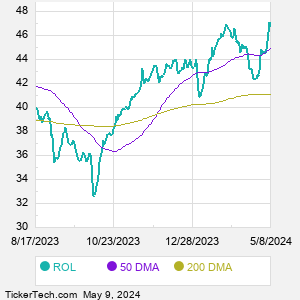Rollins is an international services company that provides pest and termite control services to both residential and commercial customers through its subsidiaries and independent franchises. Co. operates under one reportable segment which contains its three business lines: Residential, which includes pest control services protecting residential properties from common pests, including rodents, insects and wildlife; Commercial, which includes workplace pest control solutions for customers across various end markets such as healthcare, foodservice and logistics; and Termite, which includes baiting termite protection services and ancillary services for both residential and commercial customers.
When researching a stock like Rollins, many investors are the most familiar with Fundamental Analysis — looking at a company's balance sheet, earnings, revenues, and what's happening in that company's underlying business. Investors who use Fundamental Analysis to identify good stocks to buy or sell can also benefit from ROL Technical Analysis to help find a good entry or exit point. Technical Analysis is blind to the fundamentals and looks only at the trading data for ROL stock — the real life supply and demand for the stock over time — and examines that data in different ways. One of those ways is to calculate a Simpe Moving Average ("SMA") by looking back a certain number of days. One of the most popular "longer look-backs" is the ROL 200 day moving average ("ROL 200 DMA"), while one of the most popular "shorter look-backs" is the ROL 50 day moving average ("ROL 50 DMA"). A chart showing both of these popular moving averages is shown on this page for Rollins. Comparing two moving averages against each other can be a useful visualization tool: by calculating the difference between the ROL 200 DMA and the ROL 50 DMA, we get a moving average convergence divergence indicator ("ROL MACD"). The ROL MACD chart, in conjunction with the chart of the moving averages, basically helps in visualizing how the moving averages are showing convergence (moving closer together), or divergence (moving farther apart). |



